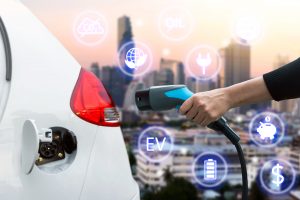 In 1888, German inventor Andreas Flocken created what is widely considered the world’s first electric car. According to The Battery Issue, recently published by The Verge, the 900-pound vehicle drove at the top speed of nine miles per hour, coming to a halt after a two and a half hour test ride. Although it was considered a success, it wasn’t entirely. The car’s battery, sustainably charged with water power, had died.
In 1888, German inventor Andreas Flocken created what is widely considered the world’s first electric car. According to The Battery Issue, recently published by The Verge, the 900-pound vehicle drove at the top speed of nine miles per hour, coming to a halt after a two and a half hour test ride. Although it was considered a success, it wasn’t entirely. The car’s battery, sustainably charged with water power, had died.
Today, nearly 130 years, German carmakers are still having trouble with their batteries – specifically with battery cells. As a result, car companies are relying on suppliers from China, Korea, and Japan for the highly needed component.
“Cells can be a major technology differentiator and cells are the by far most costly part of the battery pack,” says Martin Winter, a professor of materials science, energy, and electrochemistry at the University of Münster and ECS Battery Division and Europe Section member. Winter says a large scale production of battery cells by European or German companies will be crucial in order to take part in the “enormous and rapidly growing market.”
It’s true, batteries are everywhere and the market for batteries is vast. Batteries aren’t only in our cars, they’re also near and dear to our hearts, like pacemakers. They’re in planes, trains, scooters, Bluetooth speakers, toothbrushes, satellites; they help keep the world moving, quite literally. It’s no surprise that lithium-ion batteries are estimated to become a $94 billion global market by 2025.
Yet, breakthroughs in battery technology are few and far between. Lithium-ion batteries of today are iterations of a technology developed almost 40 years ago. But scientists are trying. And what they’re trying for is to be the first to create a “super battery.” A “super battery” that will allow electric cars to travel many hundreds of miles on a single charge or allow massive battery banks to gather and store enough restorable energy to make fossil fuels obsolete.
The first country to unlock the “super battery” could have a revolutionary impact on that economy and according to Steve LeVine, author of The Powerhouse: Inside the Invention of a Battery to Save the World. And in LeVine’s opinion, South Korea is winning.
“The South Koreans have, every year, pulled more energy out of the batteries and made them cheaper,” says LeVine.
LeVine says that doesn’t mean the U.S. isn’t in the game. The U.S. is known as the inventor of the technology field, home of American Scientist and ECS Battery Division member John Goodenough, one of the creators of the lithium-ion battery in everyone’s smartphone. Not to mention, American Scientist and ECS Battery Division and Chicago Section member Mike Thackeray, a cocreator of the battery found in most electric cars today.
Regardless, at this point, it’s anyone’s game. And opportunities for scientists to meet, share ideas, and work together are more important than ever. Meetings like ECS’s Americas International Meeting on Electrochemistry and Solid State Science (AiMES 2018) offers a place for researchers in the battery field to hear from leading innovators like John Goodenough. Can’t make it? Join ECS’s battery division and get the scoop the Goodenough’s latest work, among other breaking research papers. Visit ECS for more information.


